

 |
 |
Tal Soffer and Anat Cohen
Tel Aviv University
The study presented in this paper examines the feasibility of using MOOCs as a learning environment in academic courses. This paper focuses on the students who participated in two MOOCs offered by Tel Aviv University (TAU) during the year 2013. The preliminary findings of this pilot study illustrate the scope of student activity, the learning intensity, and learner path. In addition, attitudes of TAU students who participated in these courses as part of their curriculum are presented. From TAU’s perspective, the presented MOOCs are considered to be a successful experience for all those involved: the students, who were very satisfied with their learning and high achievements; the lecturer team, who were very enthusiastic and satisfied with the learning process as well as the new experience; and the University policy makers, who took the challenge and integrated this new model of learning into the academic environment.
Keywords: MOOC; OER; higher education; online learning; Coursera
Massive open online courses (MOOCs) are the latest revolution in online teaching and learning (Liyanagunawardena, Adams, & Williams, 2013). These academic courses are available to the general public, worldwide; do not have any preconditions; and are usually free of charge (Johnson, Adams Becker, Cummins, Estrada, Freeman, & Ludgate, 2013; Allen & Seaman, 2014; Adams & Williams, 2013; Fini, 2009; Stewart, 2013). MOOCs are offered by a variety of initiatives, such as Coursera, Udemy, MITx, edX, Udacity, which include the world’s leading universities: Stanford, Harvard, and MIT. The courses are taught by some of the most leading-edge professors around the world, in various fields. They allow for flexible learning at any time and any place, integrating a variety of tasks into the course structure. The structure and scope of each course varies, depending on the characteristics and needs of the course curriculum, and the instructor’s decision. A major emphasis is put on selecting suitable course subjects, instructors, the appropriate structure for high quality video production, and a friendly interface. Such courses developed with these guidelines have altered the conception of education and created a different culture of learning, one which involves collaborative social learning combined with various social tools (such as discussion groups and assessment process management tools). This type of course development enables the teaching of mass online courses.
In the year 2013, Tel Aviv University (TAU) joined the community of leading universities that provide MOOCs, after developing high-quality academic courses that are accessible to the public. TAU offers three academic MOOCs, taught in English, in the fields of archeology, history and science. The courses are available through Coursera (see https://www.coursera.org), an international education company that offers over 620 academic courses taught by the best lecturers from 108 academic institutions worldwide, including a number of leading universities, such as Princeton and Stanford. These courses are offered as a public service and as future training for the information society. In addition, as a pioneer step, TAU policy makers have allowed TAU undergraduate students to take these MOOCs as part of their current curriculum and receive academic credit for them upon completion.
Although there is a debate about the advantages of MOOCs and their potential negative consequences (Borden, 2014; Decker, 2014; Samuels, 2014; Shirky, 2012; Carey, 2013), universities cannot ignore the impact MOOCs have on higher education institutions. Therefore, it is important to explore the feasibility and advantages of MOOCs as part of the academic curriculum. And hence, the main goal of this research is to examine the feasibility of using MOOCs as a learning environment in academic courses. This paper will focus on the students who participated in the first two TAU MOOCs during the year 2013 – archeology and life sciences (the third is still ongoing). It will present the scope of student activity, the learning intensity, and learner path, in addition to attitudes of TAU students who participated in these courses as part of their curriculum for their degree.
The rapid growth of MOOCs, which are offered by the best universities in the world through varied initiatives (such as Coursera, Udemy, edX, MITx, Udacity, and OpenupEd) stimulate reactions of enthusiasm, and concern as well (Krause & Lowe, 2014; Abhijit & Duflo, 2014; Yuan, Powell, 2013). On one hand, spirits of innovation, new pedagogies and greater accessibility to education can be found (Kop, Fournier, & Mak, 2011; Milligan, Littlejohn, & Margaryan, 2013). On the other hand, criticism and objections are increasing along with evaluation studies and position papers whose attitudes towards MOOCs are suspicious or resistant (Samuels, 2014). To some extent, this situation balances the enthusiasm that has gripped the public.
A MOOC is an online course with the option of free and open registration, a publicly shared curriculum, and open-ended outcomes. MOOCs integrate social networking, accessible online resources, and are facilitated by leading practitioners in their fields of study. Most significantly, MOOCs build on the engagement of learners who self-organize their participation according to learning goals, prior knowledge and skills, and common interests. (McAuley, Stewart, Siemens, & Cormier, 2010)
Some of the MOOCs provide a statement of accomplishment for students who meet the passing criteria of the course. In addition, some of the institutions offer the option to earn an official verified certificate, which costs money and securely links the student’s coursework to the student’s identity (e.g., Coursera’s “Signature Track”). These certificates, however, do not include course credit towards an academic degree. Although all MOOCs have their large scale of registered students and free access in common, they have bifurcated in two very distinct and separate pedagogical types of courses, known as xMOOCs and cMOOCs (Siemens, 2013; Rodriguez, 2013). xMOOCs represent online learning environments which focus on scalability and address very large classes, while cMOOCs represent online learning environments which focus on community and connections, and are designed based on connectivism and connective knowledge (Ravenscroft, 2011). These MOOCs continue to use the acronym MOOCs, which was first coined by Siemens and Downes (Cormier & Siemens, 2010). There are researchers who argue that the xMOOCs might be better suited for studying a wide range of knowledge that can be learned through repetitive practice, while the cMOOCs enable learners to obtain “higher order creative skills” (Grünewald, Meinel, Totschnig, & Willems, 2013). Thus, these two pedagogical types shouldn’t be treated or evaluated in the same way (Daniel, 2012). Both types of MOOCs emphasize dialogue as an important element in the learning process. Almost every MOOC actively encourages dialogue and discussion among course participants. Furthermore, dialogue is actually perceived to be the primary mechanism for maintaining connections between different ideas, which are the base upon which knowledge is developed (Ravenscroft, 2011).
The MOOCs phenomenon is controversial, both for its effectiveness and in terms of its potential implications on higher education. Some researchers argue that MOOCs are still not effective in regards to student needs (Adamopoulos, 2013). One piece of evidence is the low retention rate of students in these courses (Clow, 2013; Lewin, 2013). Furthermore, they claim that MOOCs have negative potential consequences on higher education (Decker, 2014; Samuels, 2014), mostly on research and development. MOOCs initiatives may disrupt the structure of higher education because of their business model, which dismantles the relationship between the three components that university activities are built on: teaching, research, and granting credit approval for courses. These researchers are concerned that the traditional business model of the university will eventually need to shift to accommodate the existence of credit-earning MOOCs (Decker, 2014). Other researchers (Shirky, 2012; Carey, 2013) believe in the tremendous potential contribution of MOOCs. They argue that MOOCs offer flexibility, affordable access, and fast-track completion at a low cost for whoever is interested in learning (Yuan, Powell, 2013). They claim that higher education institutions will have to be flexible and aware of the changes, even in light of the criticism raised by recent studies. Regarding students, several factors can be found for their motivation in using MOOCs (Belanger & Thornton, 2013; Zutshi, O’Hare, & Rodafinos, 2013): to support lifelong learning or to gain an understanding of the subject matter, with no particular expectations for completion or achievement; for fun, entertainment, the social experience, and the intellectual stimulation; for the convenience, often in conjunction with barriers to traditional education options; and to experience or to explore online education.
Academic accreditation is one of the key issues that arises in public debate regarding MOOCs’ effect on the higher education system (Dolan, 2014). Changes in academic recognition are usually based on localized initiatives of various academic institutions (Eaton, 2012; ACE, 2012; Masterson, 2013), such as Antioch University, which became the first US institution to offer credit for MOOC learning through Coursera. At this stage, the changes are bottom-up, not top-down, as a result of planed policy and official regulation of governmental institutions or other central organizations in the USA higher education system. It is important to note that, in general, the higher education system in the USA is characterized by decentralization and high variability between institutions and between states; therefore, this phenomenon is not unusual. However, some of the most important USA central organizations in higher education have published statements recently in which they acknowledge their growing awareness of the importance of the debate in this field as well as their attempts to match system practices to the developing reality. In addition, academic recognition issues related to MOOCs were published recently in the UK as well. According to the “Universities UK”, the representative organization for UK universities (2013), currently there are still no statements of systematic recognition of MOOC studies at higher education institutions in the UK; however, there are specific instances where UK higher education institutions have decided to accredit MOOCs.
The MOOCs presence is hard to ignore and the process of its adoption and expansion must be accompanied by exploring difficult questions such as: What are the problems that MOOCs could solve (Laurillard, 2014)? Do MOOCs constitute a method which aims to reduce costs, to give mass access to academic information, to improve the learning process or make it more efficient? Are MOOCs designed to close gaps, or are they designed to encourage learning and excellence? There is often tension between these two important objectives – closing gaps and learning excellence, and it is very difficult to achieve both of these goals simultaneously.
At the pinnacle of the debate on MOOCs it seems that even if they could have a negative impact on higher education, there is a responsibility to examine their advantages and obstacles, and to make some decisions. TAU joined the Coursera initiative in order to appraise the benefits of MOOCs to the university and academic instruction. These benefits include the promotion of the institution’s status on a global scale, attraction of worldwide students, and the promotion of the university’s domestic objectives, which are related to online learning and web supported academic instruction at TAU. This paper presents TAU’s experience in implementing MOOCs as part of the academic curriculum and tries to offer insights for further integration of MOOCs in higher education.
Three courses were developed in Coursera and were offered to TAU students, as well as to the general public, worldwide. The main research goal was to examine the feasibility of using MOOCs as a learning environment in academic courses for undergraduate students. This was examined through the following aspects: a) the scope of student activity, b) the student learning intensity, c) the learner path during the online course, and d) the attitudes of TAU students who participated in these courses as part of their curriculum for their degree.
This study focuses on the first two courses, since the third is still ongoing. 47,691 students registered in the first two MOOCs courses during the year 2013. 121 of the students were TAU students, and were registered for accreditation. Data regarding the students’ range of activities, their intensity of involvement in the course, and their attitudes were derived from two main sources:
The first two courses that were chosen for this study were: “What a plant knows (and other things you didn’t know about plants)”; and “The fall and rise of Jerusalem - Judah under Babylonian rule”. The development process and production of these MOOCs required tremendous attention and commitment from the instructional teams. The professors needed to acquire new teaching skills, such as how to lecture in front of a camera without students, which is very different from what they usually do. In addition, they had to familiarize themselves with the Coursera learning management system (LMS) and infrastructure, in order to adjust their pedagogy and course material. Each professor, along with their assistant, developed the course content in accordance to the pedagogical model, which was built around video lectures, quizzes, and forums. As the prerecorded lessons were put into use, content and assignments were adjusted and/or added gradually.
The duration of each course was six to eight lessons, based on the professor’s preference, with course materials and insights taken from previous MOOCs (Andres, 2013). Students, who completed the courses with a grade of at least 78, comprised of 50% quizzes and 50% final exam, received a Statement of Accomplishment. It should be noted that these courses do not earn the student academic credit, unless they are TAU undergraduate students. TAU students are allowed to take these courses as part of their academic curriculum; however, they are required to take the final exam on campus, in addition to completing the assignments and the official online course exam.
“What a plant knows” was a course that intended to present an intriguing and scientifically valid look at how plants themselves experience the world—from the colors they see to the sensations they feel, highlighting the latest research in genetics and other relevant fields. The main goals were to introduce basic plant biology by exploring plant senses (sight, smell, hearing, touch, taste, balance), to introduce biological research and scientific methods, and to get the student to question life in general and what defines us as humans (Coursera, 2013). Every week, a different topic was presented and discussed via video lectures, professor announcements, reading recommendations, a quiz, and discussion forums. Videos included illustrated presentations, interactive questions (open and closed), and hyperlinks to other resources. A final exam was conducted at the end of the course, consisting of multiple choice questions.
“The fall and rise of Jerusalem” course presented the history of Jerusalem, from the time of the Judean Kingdom during the 6th century B.C.E., to Babylonian occupation. The course included guest lectures by leading scholars, dealing with the archaeological and biblical aspects of this debated topic (Coursera, 2013). Each week, a new topic was taught using 6 - 12 short videos. The videos included presentations and illustrations, interactive questions (open and closed), and links to the course forums and other sources. In addition, instructor messages were sent to students prior to each class along with reading recommendations. A final exam was conducted at the end of the course, using the peer review method for evaluation.
The scope of student activity – Data regarding the scope and intensity of activity was taken from Coursera’s log files at the end of each course. Students from 126 different countries signed up for these courses; the highest rates of participation were from the United States and Canada (41%) and various European countries (28%). Table 1 presents the total number of students who registered for the courses, the number of active students and the number of students who completed the assignments for each course.
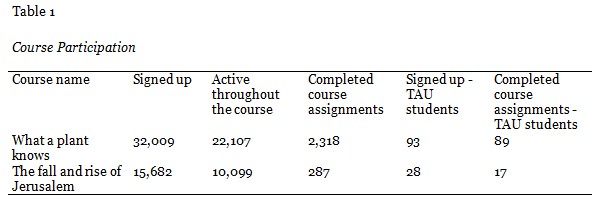
Of the 32,009 students who signed up for the first course, 2,318 students fully completed it. 89 of those students were from TAU. This data shows that 10% of the total active students (those who accessed the course items at least once) completed the course, or 7% of those who registered. These percentages match previously reported data in literature, showing that approximately 7% -10% of students who sign up for a MOOC actually complete it (Daniel, 2012; Kolowich, 2013; Koller, 2013). However, when examining the number of students who completed the course in comparison to those who registered for the “Signature Track” (and paid), the percentage was higher (62.5%). In regards to TAU students, the number of students who completed the course was even higher (97%), and their average final grade was 91.07. Focusing on the second course, only 287 of the 15,682 registered students completed the course and successfully submitted all of the assignments. 17 students were from TAU, and their average final grade was 88.88. This data shows that the second course had a relatively lower percentage of completion than the first course: approximately 2% of the total active students, 40% of those who registered for the “Signature Track”, and 60% of TAU students. Possible explanations could be the high-level subject, the depth of the material taught, and the peer-based final evaluation, which requires a greater time investment from the student. TAU students, who completed the second course, were required to take an additional final exam of open questions conducted at the University.
The intensity of usage was examined based on the following parameters: activity related to video lessons, scope of posts made on the forums, and rate of quiz submission. Table 2 presents the various activities by type of task as well as the student participation for each task. As shown, the highest volume of activity was in the video lessons. The total number of video lessons in both courses ranged from 50 to 53, which had been observed by 80% of the active students. Each student watched between 18 and 23 video lessons, on average, during the course. Examining student activity in the forums shows lower rates, compared to the video lessons. In each of the two courses, six forums were opened with various topics (e.g., general discussion, study groups, assignments and technical issues). In the first course, 9% - 11% of the active students participated in the forums and posted comments and messages. Each student wrote an average of approximately 3 posts and 2 comments. In the second course, the rate of participation was even lower and only 3% - 6% of the active students participated and posted messages. Each student wrote an average of approximately 3 posts and 5 comments. Looking at the quiz tasks in the first course, which included six quizzes, 40% of all active students participated. However, in the second course, which included five quizzes, only 18% of all active students participated. In both courses, each student submitted an average of four quizzes. Comparing student activity from both courses, we learned that although the total number of participants varied greatly, the average participation for a student in all activities was almost the same.
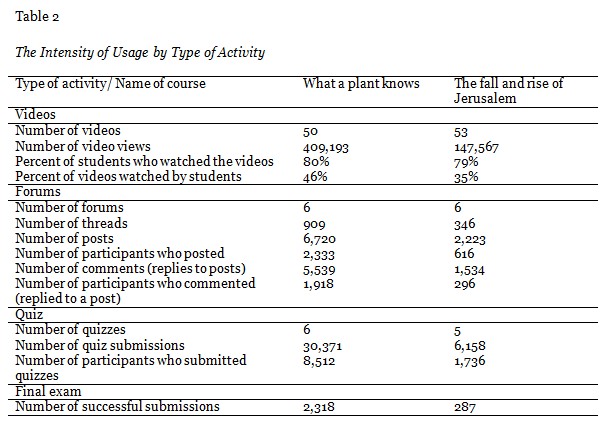
The learner path was analyzed according to the various assignments during each course. Figures 1 and 2 present the student participation in each of the courses, throughout the duration of the course. During the first few weeks of each course, there were a significantly high number of students participating in all of the activities. This number gradually decreased as the courses progressed. However, it is interesting to note that prior to the final test, there was an increase in the number of students who entered the forum. This activity, in both courses, lasted for approximately three weeks after the end of the teaching period and the final assignment submission.
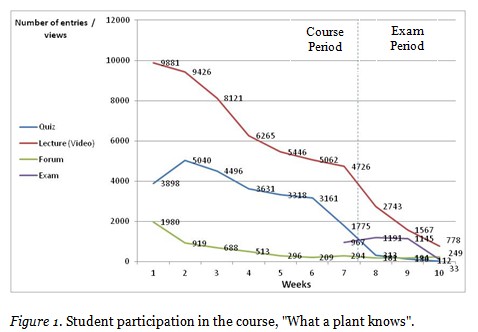
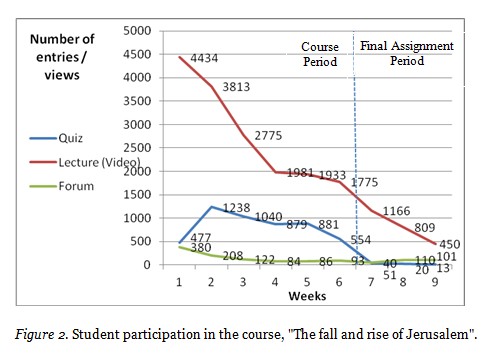
The attitude of TAU students towards MOOCs courses being a part of their curriculum was analyzed based on the results of the teaching evaluation surveys. 121 TAU students participated in the MOOCs: 93 students in the first course - “What a plant knows”, and 28 students in the second course - “The rise and fall of Jerusalem”; most of them were 2nd year undergraduate students. In the first course, participants had a similar gender ratio, whereas the second course had a majority of male students (82%). Figure 3 presents the findings of the surveys from both courses: In general the students in both courses mentioned that they were satisfied from learning in the MOOCs. However, the students in the course, “What a plant knows”, rated a higher level of satisfaction (very high) in all aspects (general average = 6.39 on a scale of 1 to 7) compared to the students in the course, “The rise and fall of Jerusalem” (overall average = 5.14). One explanation mentioned by the students was that the course, “The rise and fall of Jerusalem”, was difficult to understand for students with no previous background in the subject.
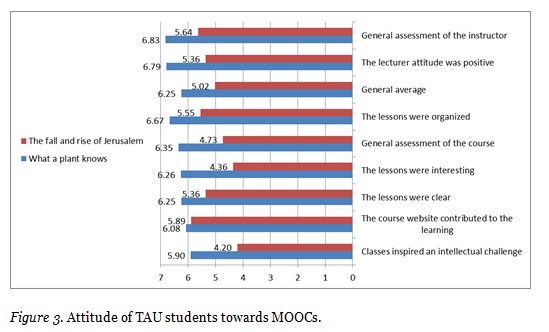
In analyzing the open questions, several interesting comments were mentioned by the students: The students in the course, “What a plant knows,” indicated that the subject matter and content was clear, interesting, inspiring, well organized, and diverse. The video lesson learning method enabled them to experience activities which are not available in traditional classes, such as virtually visiting relevant sites and interviewing visiting lecturers. They also mentioned the valuable convenience of flexible learning – any place and any time, according to their schedule. In addition, several suggestions for improvement were made, such as receiving specific guidelines regarding course assignments and especially the final test, adding subtitles to videos to assist with any language issues, and addressing the imbalance between the difficulty level of the assignments and quizzes versus the final exam. Students mentioned their satisfaction with the lecturers of both courses, noting that the instructors were clear, interesting, engaging, stimulated thinking, and had an active presence in the forum tasks. Finally, the students in the course, “The fall and rise of Jerusalem,” claimed that the course subject matter was difficult even for people who major in archeology.
In recent years, the use of MOOCs offered by leading universities to the general public has expanded. However, only 5% of higher education institutions in the USA offer such courses and only 9.3% report that they are still in a consideration phase. Moreover, only 25% of academic policy makers believe that MOOCs are a sustainable and reliable method for online courses over time (Allen & Seaman, 2014). In addition, fewer universities allow their students to take the MOOCs as part of their academic curriculum (Eaton, 2012; ACE, 2012; Masterson, 2013); nevertheless, more universities are increasingly exploring ways to incorporate MOOCs as part of their academic curriculum in different models (Firmin, Schiorring, Whitmer, Willett, Collins & Sujitparapitaya, 2014; Taneja & Goel, 2014; Joseph & Nath, 2013).
Although the debate concerning benefits and disadvantages of MOOCs to higher education is still ongoing (Borden, 2014), as well as the acceptance and accreditation of these courses by the universities, we cannot stop the “train” that has already left the station by ignoring the educational trends and the continuous penetration of emerging information and communication technologies (ICTs) into the education system. These new technologies will enable the development of innovative virtual learning environments, which will provide a variety of learning models such as MOOCs. These environments are focused on flexible learning any time anywhere, are context based, and are built up dynamically around content through learner participation, creation of user-generated content, and collaboration. Furthermore, they have the potential to give rise to communities of practice, enhance learning, and build personal learning networks (Chattopadhyay, 2014). These new models raise many questions concerning the transition from the physical space of the classroom, where the students and lecturer are present, to a virtual space where the students and the instructor use computers for learning, communicating, dialogue, encouraging learning, trying to prevent dropout, giving feedback, evaluating work, and so on.
One of the major challenges concerning the penetration of MOOCs is the university accreditation given to these courses. TAU took this challenge and developed three MOOCs in different fields of study (archeology, biology, and Middle Eastern studies). These courses are offered to the general, worldwide public, and are accredited to TAU students as part of their academic curriculum. Additionally, a research and practicum group was created to accompany course development and gain critical experience in online instruction.
The pilot study presented in this paper illustrates the feasibility of implementing MOOCs as part of the academic curricula for undergraduate students, and describes the scope and intensity that exists in TAU courses in terms of learning, teaching, and assessing, especially during the early stages of a course. The preliminary data presented in this article indicate that the number of worldwide students who participated in these courses was very impressive (about 50,000 subscribers of which over 30,000 were active in two courses). The MOOCs penetration into the higher education system offers an alternative learning model, which includes a wide variety of activities, such as video lessons, interactive participation in forums, online tasks, and feedback. The TAU MOOCs are considered to be a successful experience for all those involved: the students, who were very satisfied with their courses and their achievements; the lecturers, who were very enthusiastic and satisfied with the learning process, as well as the new experience; and the University policy makers, who took the challenge and integrated this new model of learning into the academic environment. From the academic point of view, following the MOOCs success at TAU, further activities will be considered, such as increasing the number of MOOCs, integrating them into the academic curricula, and creating an international academic program with other universities for special issues. Thus, integrating MOOCs in academic institutions for undergraduate learners could provide several advantages: flexible learning environments; enrichment with courses by leading instructors in various fields; and exposure to intercultural learning experiences from which 21st century skills can be attained. On the other hand, we must take several issues into consideration: developed economical models, academic pedagogical standards, quality assurance, and student needs at the university.
Most recent studies (Cormier & Siemens, 2010; Daniel, 2012; Rodriguez, 2012: Swan, Day, Bogle, & van Prooyen, 2014) on the MOOCs phenomenon mainly examine the benefits of this model from pedagogical, social, and technological aspects; however, future studies should also focus on the processes of running MOOCs, the advantages of integrating them into the academic curriculum, as well as on issues such as copyright, privacy, cultural differences (including language), and economic and organizational aspects.
This research was part of an evaluation undertaken by the authors for assessing the implementation of MOOCs at TAU. The authors follow Coursera’s commitment to protect student privacy. As described in its working policy, student names and e-mail addresses are regarded as personally identifiable information (PII). This PII data is handled very carefully and is not included in research data exports. As outlined in the Coursera Company’s Terms of Service and Privacy Policy, students who participate in Coursera’s online classes do so with the expectation that Coursera will maintain the privacy of their academic records. In this research the authors used the data according to Coursera’s ethical guidelines regarding the students of the two MOOCs. The data used in this research will be supplied upon request. There is no conflict of interest in the reported research.
The authors would like to thank TAU Financial Company for the MOOCs development, and Coursera for their invaluable support in obtaining permission and yielding access to the course data analyzed in this paper.
Abhijit B. V., & Duflo, E. (2014). (Dis)organization and success in an economics MOOC. American Economic Review, 104(5), 514-18.
ACE, American Council on Education. (2012). ACE to assess potential of MOOCs, evaluate courses for credit-worthiness. Retrieved from http://www.acenet.edu/news-room/Pages/ACE-to-Assess-Potential-of-MOOCs-Evaluate-Courses-for-Credit-Worthiness.aspx
Adamopoulos, P. (2013). What makes a great MOOC? An interdisciplinary analysis of student retention in online courses. Thirty Fourth International Conference on Information Systems, Milan 2013. Retrieved from http://www.phd-in-progress.com/wp-content/uploads/2014/02/08.pdf
Adams, A. A., Liyanagunawardena, T. R., Rassool, N., & Williams, S. (2013). Use of open educational resources in higher education. British Journal of Educational Technology, 44(5), 149-150.
Allen, E., & Seaman, J. (2014). Grade change: Tracking online education in the United States. Babson Survey Research Group and Quahog Research Group, LLC.
Anders, G. (2013, October 10). Coursera’s online insight: Short classes are education’s future. Forbes. Retrieved from http://www.forbes.com/sites/georgeanders/2013/10/10/courseras-online-insight-short-classes-are-educations-future/
Antioch University Becomes First US Institution to Offer Credit for MOOC Learning Through Coursera, October 29, 2012. Retrieved from http://www.antioch.edu/antioch-announcement/antioch-university-becomes-first-us-institution-to-offer-credit-for-mooc-learning-through-coursera/
Belanger, Y., & J. Thornton. 2013. Bioelectricity: A quantitative approach. Duke University’s first MOOC. Duke University Libraries. Retrieved from http://hdl.handle.net/10161/6216
Borden, J. (2014). MOOCs Are dead - Long live the MOOC. Retrieved from http://www.wired.com/2014/08/moocs-are-dead-long-live-the-mooc/
Carey, K., (2013), Obama, Rubio agree on one thing: Technology could fix the higher ed mess. Retrieved from http://tinyurl.com/cogw2kh
Chattopadhyay, S. (2014). 11 Differences between a MOOC and an online course. Retrieved from http://idreflections.blogspot.co.nz/2014/06/11-differences-between-mooc-and-online.html
Clow, D. (2013). Moocs and the funnel of participation. In Proceedings of the Third International Conference on Learning Analytics and Knowledge. Leuven, Belgium: ACM, pp. 185-189.
Cormier, D., & Siemens, G. (2010). The open course: Through the open door—open courses as research, learning, and engagement. Educause Review, 45(4), 30. Retrieved from http://www.educause.edu/EDUCAUSE+Review/EDUCAUSEReviewMagazineVolume45/ThroughtheOpenDoorOpenCoursesa/209320
Daniel, J. (2012). Making sense of MOOCs: Musings in a maze of myth, paradox and possibility. Journal of Interactive Media in Education. Retrieved from http://www-jime.open.ac.uk/jime/article/viewArticle/2012-18/html
Decker, G. L. (2014). MOOCology 1.0. In Krause, S., & Lowe, C. (Eds), Invasion of the MOOCs: The promise and perils of massive open online courses. Parlor Press: South Carolina.
Dolan, V. L. (2014). Massive online obsessive compulsion: What are they saying out there about the latest phenomenon in higher education? The International Review of Research in Open and Distance Learning, 15(2).
Eaton, J. S. (2012). CHEA, MOOCs and Accreditation: Focus on the quality of ‘direct-to-students’ education. Inside Accreditation, 9(1). Retrieved from http://www.chea.org/ia/IA_2012.10.31.html
Fini, A. (2009). The technological dimension of a massive open online course: The case of the CCK08 course tools. International Review of Research in Open and Distance Learning, 10(5), 74-96.
Firmin, R., Schiorring, E., Whitmer, J., Willett, T., Collins, E. D., & Sujitparapitaya, S. (2014). Case study: using MOOCs for conventional college coursework. Distance Education, 35(2), 178-201, DOI: 10.1080/01587919.2014.917707
Grünewald, F., Meinel, C., Totschnig, M., & Willems, C. (2013). Designing MOOCs for the support of multiple learning styles. In Scaling up learning for sustained impact (pp. 371-382). Springer Berlin Heidelberg.
Johnson, L., Adams Becker, S., Cummins, M., Estrada, V., Freeman, A., & Ludgate, H. (2013). NMC Horizon Report: 2013 higher education edition. Austin, Texas: The New Media Consortium.
Joseph, A. M., & Nath, B. A. (2013). Integration of massive open online education (MOOC) system with in-classroom interaction and assessment and accreditation: An extensive report from a pilot study. Retrieved from http://weblidi.info.unlp.edu.ar/WorldComp2013-Mirror/p2013/EEE3547.pdf
Koller, D. (2013). MOOCs and the revolution in higher education. Retrieved from http://www.youtube.com/watch?v=ZWaYpwT0j8c
Kolowich, S. (2013). Coursera takes a nuanced view of MOOC dropout rates. The Chronicle of Higher Education. Retrieved from http://chronicle.com/blogs/wiredcampus/coursera-takes-a-nuanced-view-of-mooc-dropout-rates/43341
Kop, R., Fournier, H., & Mak, J. S. F. (2011). A pedagogy of abundance or a pedagogy to support human beings? Participant support on massive open online courses. The International Review of Research in Open and Distance Learning, 12(7), 74-93.
Krause, S., & Lowe, C. (2014). Invasion of the MOOCs: The promise and perils of massive open online courses. Parlor Press: South Carolina. Retrieved from http://www.parlorpress.com/pdf/invasion_of_the_moocs.pdf
Laurillard, D. (2014). Which problems could MOOCs solve, and how? Retrieved from http://www.universityworldnews.com/article.php?story=20140708091436155
Lewin, T. (2013). Universities abroad join partnerships on the web. The New York Times. February 21, 2013: p. A18. Retrieved from http://www.nytimes.com/2013/02/21/education/universities-abroad-join-mooc-course-projects.html?_r=0
Liyanagunawardena, T. R., Adams, A. A., & Williams, S.A. (2013). MOOCs: A systematic study of the published literature 2008-2012. International Review of Research in Open and Distance Learning, 14(3), 202-227.
Masterson, K. (2013). Giving MOOCs some credit. ACE. Retrieved from http://www.acenet.edu/the-presidency/columns-and-features/Pages/Giving-MOOCs-Some-Credit.aspx
McAuley, A., Stewart, B., Siemens, G., & Cormier, D. (2010). The MOOC model for digital practice. Retrieved from https://oerknowledgecloud.org/sites/oerknowledgecloud.org/files/MOOC_Final_0.pdf
Milligan, C., Littlejohn, A., & Margaryan, A. (2013). Patterns of engagement in connectivist MOOCs. MERLOT Journal of Online Learning and Teaching, 9(2).
OpenupEd (2014). The portal of a pan-European initiative OpenupEd around so-called MOOCs (massive open online courses). Retrieved from http://www.openuped.eu/
Ravenscroft, A. (2011). Dialogue and connectivism: A new approach to understanding and promoting dialogue-rich networked learning. The International Review of Research in Open and Distance Learning, 12(3), 139-160.
Rice, W. H. (2006). Moodle e-learning course development. A complete guide to successful learning using Moodle. Packt Publishing.
Rodriguez, O. (2012). MOOCs and the AI-Stanford like courses: Two successful and distinct course formats for massive open online courses. European Journal of Open, Distance and E-learning, 2012(2). Retrieved from http://www.eurodl.org/materials/contrib/2012/Rodriguez.pdf
Rodriguez, O. (2013). The concept of openness behind c and x-MOOCs (massive open online courses). Open Praxis, 5(1), 67-73.
Samuels, B. (2014). Being present in a university writing course: A case against MOOCs. In Krause, S., & Lowe, C. (Eds), Invasion of the MOOCs: The promise and perils of massive open online courses. Parlor Press: South Carolina.
Shirky, C. (2012, November 12). Napster, Udacity, and the academy [Web log post]. Retrieved from http://www.shirky.com/weblog/2012/11/napster-udacity-and-the-academy/
Siemens, G. (2013). Massive open online courses: Innovation in education? Open Educational Resources: Innovation, Research and Practice, 5.
Stewart, B., Briton , D., Gismondi, M., Heller , B., Kennepohl, D., McGreal, R., & Nelson, C. (2007). Choosing Moodle: An evaluation of learning management systems at Athabasca University. Journal of Distance Education Technologies, 5(3), 1-7.
Stewart, B. (2013). Massiveness + openness = New literacies of participation? MERLOT Journal of Online Learning and Teaching, 9(2), 228-238. Retrieved from http://jolt.merlot.org/vol9no2/stewart_bonnie_0613.htm
Swan, K., Day, S., Bogle, L., & van Prooyen, T. (2014). AMP: A tool for characterizing the pedagogical approaches of MOOCs. e-mentor, 2(54), 75-85.
Taneja, S., & Goel, A. (2014). MOOC providers and their strategies. International Journal of Computer Science and Mobile Computing, 3(5), 222 - 228.
Universities UK (2013). Massive open online courses - higher education’s digital moment? May 2013. Retrieved from http://www.universitiesuk.ac.uk/highereducation/Documents/2013/MassiveOpenOnlineCourses.pdf
Yuan, L., & Powell, S. (2013). MOOCs and open education: Implications for higher education. Cetis White Paper. Centre for Educational Technology, Interoperability and Standards and JISC. Retrieved from http://publications.cetis.ac.uk/2013/667
Zutshi, S., O’Hare, S., & Rodafinos, A. (2013). Experiences in MOOCs: The perspective of students. American Journal of Distance Education, 27(4), 218-227.
© Soffer and Cohen